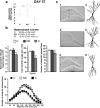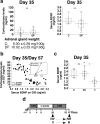Vulnerability to depression: from brain neuroplasticity to identification of biomarkers
- PMID: 21900567
- PMCID: PMC6623387
- DOI: 10.1523/JNEUROSCI.1309-11.2011
Vulnerability to depression: from brain neuroplasticity to identification of biomarkers
Abstract
A stressful event increases the risk of developing depression later in life, but the possible predisposing factors remain unknown. Our study aims to characterize latent vulnerability traits underlying the development of depressive disorders in adult animals. Four weeks after a priming stressful event, serum corticosterone concentration returned to control values in all animals, whereas the other biological parameters returned to basal level in only 58% of animals (called nonvulnerable). In contrast, 42% of animals displayed persistent decreased serum and hippocampus BDNF concentrations, reduced hippocampal volume and neurogenesis, CA3 dendritic retraction and decrease in spine density, as well as amygdala neuron hypertrophy, constituting latent vulnerability traits to depression. In this group, called vulnerable, a subsequent mild stress evoked a rise of serum corticosterone levels and a "depressive" phenotype, in contrast to nonvulnerable animals. Intracerebroventricular administration of 7,8-dihydroxyflavone, a selective TrkB receptor agonist, dampened the development of the "depressive" phenotype. Our results thus characterize the presence of latent vulnerability traits that underlie the emergence of depression and identify the association of low BDNF with normal corticosterone serum concentrations as a predictive biomarker of vulnerability to depression.
Figures









Similar articles
-
Differential effects of imipramine and CORT118335 (Glucocorticoid receptor modulator/mineralocorticoid receptor antagonist) on brain-endocrine stress responses and depression-like behavior in female rats.Behav Brain Res. 2018 Jan 15;336:99-110. doi: 10.1016/j.bbr.2017.08.045. Epub 2017 Sep 1. Behav Brain Res. 2018. PMID: 28866130
-
The hippocampus, neurotrophic factors and depression: possible implications for the pharmacotherapy of depression.CNS Drugs. 2011 Nov 1;25(11):913-31. doi: 10.2165/11595900-000000000-00000. CNS Drugs. 2011. PMID: 22054117 Review.
-
Dammarane sapogenins alleviates depression-like behaviours induced by chronic social defeat stress in mice through the promotion of the BDNF signalling pathway and neurogenesis in the hippocampus.Brain Res Bull. 2019 Nov;153:239-249. doi: 10.1016/j.brainresbull.2019.09.007. Epub 2019 Sep 19. Brain Res Bull. 2019. PMID: 31542427
-
St John's wort, hypericin, and imipramine: a comparative analysis of mRNA levels in brain areas involved in HPA axis control following short-term and long-term administration in normal and stressed rats.Mol Psychiatry. 2001 Sep;6(5):547-64. doi: 10.1038/sj.mp.4000937. Mol Psychiatry. 2001. PMID: 11526469
-
Biomarkers in pediatric depression.Depress Anxiety. 2013 Sep;30(9):787-91. doi: 10.1002/da.22171. Epub 2013 Aug 22. Depress Anxiety. 2013. PMID: 24002798 Free PMC article. Review. No abstract available.
Cited by
-
Hippocampal volume and total cell numbers in major depressive disorder.J Psychiatr Res. 2013 Mar;47(3):299-306. doi: 10.1016/j.jpsychires.2012.10.020. Epub 2012 Nov 30. J Psychiatr Res. 2013. PMID: 23201228 Free PMC article.
-
Carnitine and Depression.Front Nutr. 2022 Mar 14;9:853058. doi: 10.3389/fnut.2022.853058. eCollection 2022. Front Nutr. 2022. PMID: 35369081 Free PMC article. Review.
-
The prodrug of 7,8-dihydroxyflavone development and therapeutic efficacy for treating Alzheimer's disease.Proc Natl Acad Sci U S A. 2018 Jan 16;115(3):578-583. doi: 10.1073/pnas.1718683115. Epub 2018 Jan 2. Proc Natl Acad Sci U S A. 2018. PMID: 29295929 Free PMC article.
-
Neurotrophic-priming of glucocorticoid receptor signaling is essential for neuronal plasticity to stress and antidepressant treatment.Proc Natl Acad Sci U S A. 2015 Dec 22;112(51):15737-42. doi: 10.1073/pnas.1509045112. Epub 2015 Nov 16. Proc Natl Acad Sci U S A. 2015. PMID: 26630005 Free PMC article.
-
Naringin Mediates Adult Hippocampal Neurogenesis for Antidepression via Activating CREB Signaling.Front Cell Dev Biol. 2022 Apr 7;10:731831. doi: 10.3389/fcell.2022.731831. eCollection 2022. Front Cell Dev Biol. 2022. PMID: 35478969 Free PMC article.
References
-
- Alleva E, Francia N. Psychiatric vulnerability: suggestions from animal models and role of neurotrophins. Neurosci Biobehav Rev. 2009;33:525–536. - PubMed
-
- Becker C, Zeau B, Rivat C, Blugeot A, Hamon M, Benoliel JJ. Repeated social defeat-induced depression-like behavioral and biological alterations in rats: involvement of cholecystokinin. Mol Psychiatry. 2008;13:1079–1092. - PubMed
-
- Bielajew C, Konkle AT, Merali Z. The effects of chronic mild stress on male Sprague-Dawley and Long Evans rats: I. Biochemical and physiological analyses. Behav Brain Res. 2002;136:583–592. - PubMed
Publication types
MeSH terms
Substances
LinkOut - more resources
Full Text Sources
Other Literature Sources
Miscellaneous
